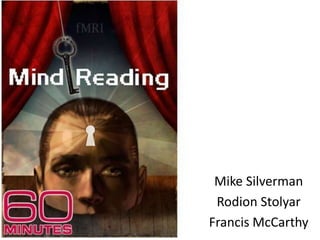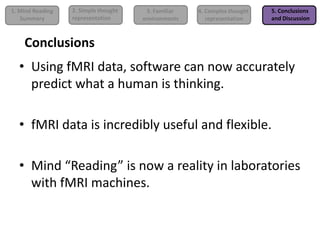Mind Reading
- 1. Mike Silverman Rodion Stolyar Francis McCarthy
- 2. The Power of Modern Neuroscience âĒ http://www.youtube.com/watch?feature =player_embedded&v=nsjDnYxJ0bo#!
- 3. 1. Mind Reading 2. Simple thought 3. Familiar 4. Complex thought 5. Conclusions Summary representation environments representation and Discussion
- 4. 1. Mind Reading 2. Simple thought 3. Familiar 4. Complex thought 5. Conclusions Summary representation environments representation and Discussion History âĒ First âBrain Imaging Experimentâ âĒ Angelo Mosso âĒ Italian Physiologist âĒ Major Break through
- 5. 1. Mind Reading 2. Simple thought 3. Familiar 4. Complex thought 5. Conclusions Summary representation environments representation and Discussion How does fMRI work? âĒ What causes an fMRI signal? Is it A or B? âĒ A) fMRI measures the REDUCTION in the amount of paramagnetic deoxygenated hemoglobin in neural tissue from a resting state to an active state. âĒ B) fMRI measures the INCREASE in the amount of paramagnetic deoxygenated hemoglobin in neural tissue from a resting state to an active state.
- 6. 1. Mind Reading 2. Simple thought 3. Familiar 4. Complex thought 5. Conclusions Summary representation environments representation and Discussion How does fMRI work? Resting State Active State
- 7. 1. Mind Reading 2. Simple thought 3. Familiar 4. Complex thought 5. Conclusions Summary representation environments representation and Discussion Just and Mitchellâs Methods âĒ fMRI data from 9 healthy college aged Tom Mitchell participants âĒ Randomly viewed 60 different word- picture pairs 6x âĒ Signal for each word-picture pair was Marcel Just recorded and averaged. âĒ Average signal used as baseline and compared to new fMRI signal from a new participant
- 8. 1. Mind Reading 2. Simple thought 3. Familiar 4. Complex thought 5. Conclusions Summary representation environments representation and Discussion Repeated for all 9 participants.
- 9. 1. Mind Reading 2. Simple thought 3. Familiar 4. Complex thought 5. Conclusions Summary representation environments representation and Discussion Do different people have the same type of brain activation patterns?
- 10. 1. Mind Reading 2. Simple thought 3. Familiar 4. Complex thought 5. Conclusions Summary representation environments representation and Discussion NEW participant gets in the fMRI machine and looks at the same word-pictures BUT this time the computer does not know what pictures the participant is looking at, it ONLY sees the brain activity pattern
- 11. 1. Mind Reading 2. Simple thought 3. Familiar 4. Complex thought 5. Conclusions Summary representation environments representation and Discussion Do different people have the same type of brain activation? New participantsâ brain activity patterns
- 12. 1. Mind Reading 2. Simple thought 3. Familiar 4. Complex thought 5. Conclusions Summary representation environments representation and Discussion John-Dylan Haynes Have you been here before?
- 13. 1. Mind Reading 2. Simple thought 3. Familiar 4. Complex thought 5. Conclusions Summary representation environments representation and Discussion John-Dylan Haynes
- 14. 1. Mind Reading 2. Simple thought 3. Familiar 4. Complex thought 5. Conclusions Summary representation environments representation and Discussion The earliest technique to see unconscious processing. John-Dylan Haynes Haynes elaborates on this phenomenon.
- 15. 1. Mind Reading 2. Simple thought 3. Familiar 4. Complex thought 5. Conclusions Summary representation environments representation and Discussion Neural decision before conscious awareness of the decision John-Dylan Haynes Conscious decision EEG signals before the âfeeling of wantingâ entered consciousness! Challenged our concept of free will
- 16. 1. Mind Reading 2. Simple thought 3. Familiar 4. Complex thought 5. Conclusions Summary representation environments representation and Discussion John-Dylan Haynes
- 17. 1. Mind Reading 2. Simple thought 3. Familiar 4. Complex thought 5. Conclusions Summary representation environments representation and Discussion Step 1: decode John-Dylan Haynes Step 2: give to computer to classify Step 3: predict
- 18. 1. Mind Reading 2. Simple thought 3. Familiar 4. Complex thought 5. Conclusions Summary representation environments representation and Discussion Conclusions âĒ Using fMRI data, software can now accurately predict what a human is thinking. âĒ fMRI data is incredibly useful and flexible. âĒ Mind âReadingâ is now a reality in laboratories with fMRI machines.
- 19. 1. Mind Reading 2. Simple thought 3. Familiar 4. Complex thought 5. Conclusions Summary representation environments representation and Discussion Discussion question 1 In the realm of criminal justice, do you think brain pattern activation is equivocal with physical evidence such as DNA, semen, etc. or is it equivocal with personal testimony and protected by the fifth amendment?
- 20. 1. Mind Reading 2. Simple thought 3. Familiar 4. Complex thought 5. Conclusions Summary representation environments representation and Discussion Discussion question 2 Can we be decisive when making conclusions about what a pattern of brain activity means? i.e. What if my brain says âI love chocolate chip cookiesâ but I say that I donât like chocolate chip cookies at all. Can we be CERTAIN? =
- 21. 1. Mind Reading 2. Simple thought 3. Familiar 4. Complex thought 5. Conclusions Summary representation environments representation and Discussion Discussion question 3 We mentioned Hayneâs study where Haynes could predict what decision youâre going to make 7 seconds before you are consciously aware of your own decision. Do you think this interferes with the notion of free will?
- 22. The End SkyNet is comingâĶbe preparedâĶ
Editor's Notes
- #3: The left clip is a segment of a Hollywood movie trailer that the subject viewed while in the magnet. The right clip shows the reconstruction of this segment from brain activity measured using fMRI. The procedure is as follows:[1] Record brain activity while the subject watches several hours of movie trailers.[2] Build dictionaries (i.e., regression models) that translate between the shapes, edges and motion in the movies and measured brain activity. A separate dictionary is constructed for each of several thousand points at which brain activity was measured.(For experts: The real advance of this study was the construction of a movie-to-brain activity encoding model that accurately predicts brain activity evoked by arbitrary novel movies.)[3] Record brain activity to a new set of movie trailers that will be used to test the quality of the dictionaries and reconstructions.[4] Build a random library of ~18,000,000 seconds (5000 hours) of video downloaded at random from YouTube. (Note these videos have no overlap with the movies that subjects saw in the magnet). Put each of these clips through the dictionaries to generate predictions of brain activity. Select the 100 clips whose predicted activity is most similar to the observed brain activity. Average these clips together. This is the reconstruction.
- #4: Paul Root Wolpe
- #6: Check this with Jonides
- #7: EXPLANATION: At both the resting state and active state, fMRI measures the amount of paramagnetic deoxygenated hemoglobin in a neural tissue.Logically you would think, active tissue uses more oxygen, expect to see more deoxygenated hemoglobin in neural tissue during an active stateBUT the increased blood flow pushes deoxygenated hemoglobin out of the area so fast that fMRI actually measures a REDUCTION from the resting stateTo the active state.
- #10: Learned voxelactivation signatures for3 of the 25 semantic features,for participant P1(top panels) and averagedover all nine participants(bottom panels). Just onehorizontal z slice is shownfor each. The semantic featureassociated with theverb âeatâ predicts substantialactivity in rightpars opercularis, which isbelieved to be part of thegustatory cortex. The semanticfeature associatedwith âpushâ activates theright postcentralgyrus,which is believed to beassociated with premotorplanning. The semantic feature for the verb ârunâ activates the posterior portion of the right superior temporalsulcus, which is believed to be associated with the perception of biological motion.
- #11: Edit this image to have new word - pictures
- #12: How accurate?Learned voxelactivation signatures for3 of the 25 semantic features,for participant P1(top panels) and averagedover all nine participants(bottom panels). Just onehorizontal z slice is shownfor each. The semantic featureassociated with theverb âeatâ predicts substantialactivity in rightpars opercularis, which isbelieved to be part of thegustatory cortex. The semanticfeature associatedwith âpushâ activates theright postcentralgyrus,which is believed to beassociated with premotorplanning. The semantic feature for the verb ârunâ activates the posterior portion of the right superior temporalsulcus, which is believed to be associated with the perception of biological motion.
- #13: http://www.bccn-berlin.de/digitalAssets/0/680_HaveYouBeenHereBefore_Xvid_English_LowResolution.aviThis will take some time 3-4 minutes
- #18: Example of voxel selectivity for a representativesearchlight (position with peak decoding accuracy in frontopolar cortex). Thespherical clusters at that position are shown for all 12 subjects. The selectivity foreach voxel for either a left or right decision is colour coded in blue and yellowrespectively. The selectivity profiles clearly indicate that some voxels areactivated stronger preceding either left or right decisions, thus pointing towards adistributed encoding of long-term predictive information.If all three of these brain regions are activated 7 seconds prior, we can
- #25: At a resting state, fMRI measures the amount of paramagnetic deoxygenated hemoglobin in a neural tissue.Active State,Increased Blood Flow,Oxygenated blood-paramagnetic,fMRI measures signal difference
- #26: Learned voxelactivation signatures for3 of the 25 semantic features,for participant P1(top panels) and averagedover all nine participants(bottom panels). Just onehorizontal z slice is shownfor each. The semantic featureassociated with theverb âeatâ predicts substantialactivity in rightpars opercularis, which isbelieved to be part of thegustatory cortex. The semanticfeature associatedwith âpushâ activates theright postcentralgyrus,which is believed to beassociated with premotorplanning. The semantic feature for the verb ârunâ activates the posterior portion of the right superior temporalsulcus, which is believed to be associated with the perception of biological motion.
- #27: Mental representations of objects vary between people.However, similarities exist.Not a carbon copy, but similar enough.






















